Aleenah Ansari
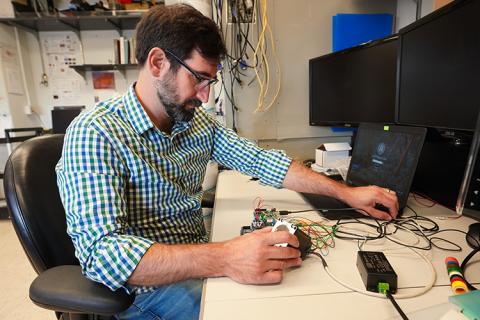
The Research Experience for Teachers program at the CNT instructs middle and high school teachers on how to introduce students to neural engineering in an inclusive, engaging and thoughtful way, while at the same time, it provides an immersive research experience for the teachers themselves.
Chris Calvin, a science teacher at Mount Rainier High School in Washington state, is passionate about science and making it engaging for his students. To achieve this goal, he is always searching for opportunities to support his teaching practice. For this reason, he decided to participate in the Research Experience for Teachers (RET), a National Science Foundation-funded program at the Center for Neurotechnology (CNT) that supports middle and high school teachers in developing research-based curriculum for science, technology, engineering and mathematics (STEM) classrooms. Participating in the RET program has allowed Calvin to be a student and researcher again.
“To be immersed in a program for seven weeks and participate in research gives you that firsthand knowledge, and makes it easier to recreate [those learning experiences] in your classroom,” Calvin said.
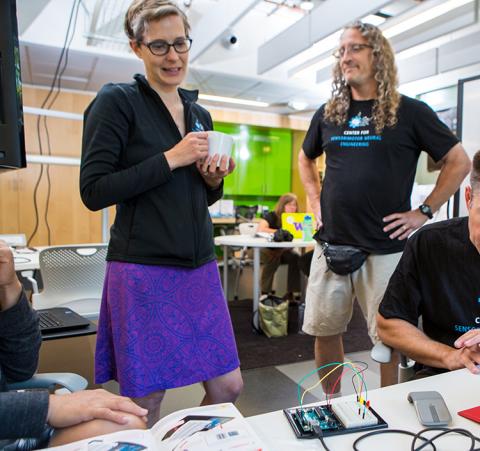
The five teachers in this year’s RET cohort are designing curricula for subjects ranging from physics to environmental science.
“We’ve been talking about how neural engineering is a great topic for showing students how authentic science can be, and how it connects to [students’] lives,” said Kristen Bergsman, the CNT engineering education research manager. “We all know someone who has a neurological disease, [so teachers] are choosing what to highlight that will really matter to their students.”
Bridging classroom practice and research
RET teachers develop curriculum that aligns with the Next Generation Science Standards (NGSS), which require teachers to bring authentic science and engineering practices into the classroom. To support inquiry-based learning, RET participants conduct a research project in a CNT-affiliated lab, which enables them to develop curricula that showcases the real-world impact of STEM through neural engineering.
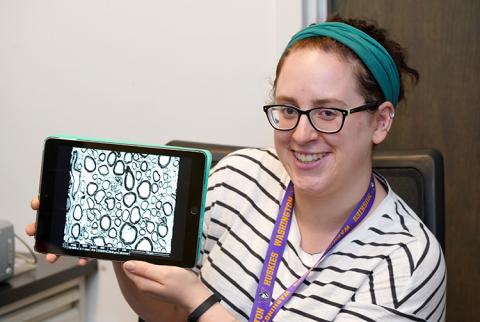
“By being immersed in a research lab, I was able to take ideas from ethicists, scientists and engineers, and synthesize them in a way that made sense to middle schoolers,” said Laura Moore, a former RET participant and lead teacher for math and science at the Eton School in Bellevue, Washington. “That was incredibly valuable.”
When designing curriculum, Bergsman said that teachers receive mentorship and guidance about how to create a space for students to experience productive failure, a form of learning where students are invited to see “failure” as a learning opportunity. Bergsman said that making mistakes is often a part of engineering, particularly when you’re solving complex problems.
“When teachers are in these labs, they see how people are struggling to collect and understand their data,” Bergsman said. “They [see] constant problem solving, and it’s something that they can bring to their students. They have stories they can share.”
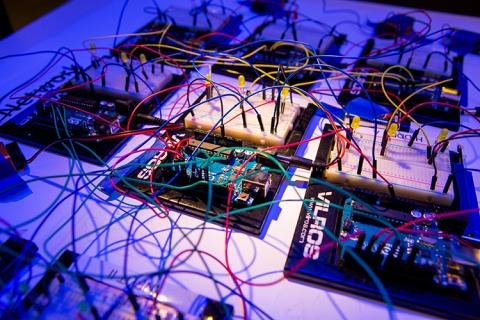
After summer at the CNT ends, teachers will pilot their curricula during the 2019 – 2020 school year. They are also able to check out supplies from the CNT for their curriculum such as Arduinos and Snap Circuits kits. For example, Sadie Frady, a second-time participant in RET and science teacher at Bethel High School in Spanaway, Washington, used the Snap Circuits kits and an EMG robotic gripper from Backyard Brains.
After piloting their curriculum, RET teachers can iterate on it during the following summer. For example, Frady is revising the curriculum she designed as a participant two years ago. Her curriculum draws parallels between circuits and the nervous system, and it culminated in an activity where students designed their own neural devices. These revised lessons plans are added to the CNT’s portfolio of online lesson plans, which are available for all teachers to use.
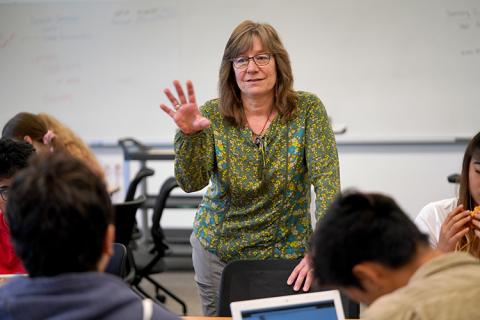
Being a student again: Conducting research that informs curriculum development
Currently, Calvin is working with the CNT-affiliated Restorative Technologies Laboratory to create a unit of curriculum that explores both fundamental physics principles and neuroscience. Calvin’s unit will explore human enhancement through electromechanical methods, and the ethical implications of using this technology. The unit culminates with students being challenged to design and build a model of an enhancement.
“The research lab is great for my creativity and thinking about how to engage students in authentic scientific practice,” Calvin said.
RETs can also share their research experience with their students, which can provide K-12 students with a glimpse into what engineering looks like in the real world. This was true for Frady, who shared how she created artificial neural networks in the CNT-affiliated Neural Systems Lab.

“I have a lot of kids that are interested in coding and science but not necessarily ‘traditional’ biology,” Frady said. “It’s valuable for them to know that you can do something biology-related in engineering.”
Currently, Calvin is developing curriculum for a high school physics class that’s catered to students who plan to take biology the following year.
Through his curriculum, Calvin hopes to teach physics in the context of neuroscience and spark his students’ interest in the subject. He hopes to do this by mimicking the engineering design process that’s used by scientists and engineers, which often involves asking open-ended questions where there is no one solution. Frady took a similar approach when she piloted her curriculum.
“Part of my curriculum focused on going through the engineering design process – making something, testing it and being okay with ‘failure,’” Frady said. “I talk [my students] through that and explain that it’s part of the engineering process.”
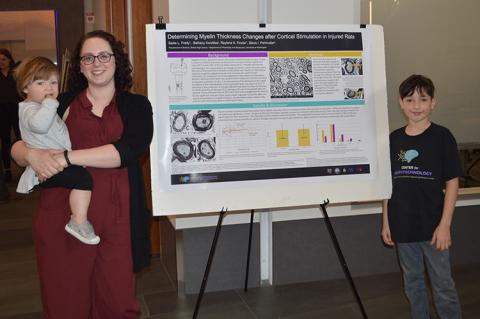
An integral part of neural engineering is neuroethics, which is a cornerstone of the CNT’s research. For this reason, Bergsman requires that teachers write a lesson plan that incorporates neuroethics, often by inviting students to think about the impact of their work.
“It’s critical to our center and part of our identity that we [have conversations] about how to think about neuroethics from the beginning all the way to when [neurotechnology] is out in the world,” Bergsman said. “I think that young people are very interested in ethics and issues of justice, security and identity.”
To address neuroethics, Frady drew inspiration from a previous RET’s curriculum. She started by inviting her students to reflect on their assumptions about who is included and excluded in society. Then, the class watches the documentary “FIXED,” which discusses different forms of human enhancement and the impact of neurotechnology on people’s lives. Afterward, students reflect on how their assumptions may have changed and why.
“We weave that conversation into the design process,” Frady said. “It gets them thinking before they even start designing.”
Providing resources to create far-reaching curricula
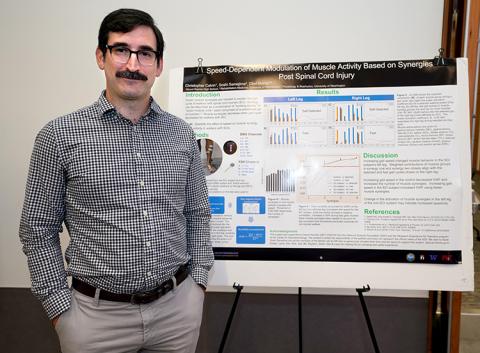
During the RET program, teachers also attend lectures that educate them about neural engineering and strategies for developing curriculum that incorporates engineering principles. For example, they conduct a sheep brain dissection, use a cockroach leg to record neural signals, and attend a lecture by Gina Tesoriero, a PhD student in the UW College of Education, about how to prioritize inclusion when developing lesson plans. One tip from Tesoriero was to move away from traditional lectures and be open to new teaching tools for introducing topics in the classroom. By doing this, Moore said that the RET curriculum can inspire students to envision themselves in the field of neural engineering.
“It can take something that would otherwise be science fiction and show that it can happen,” Moore said. “Then, they might want to become scientists or engineers because they can see themselves in that role.”
Through the program, Bergsman is available to provide resources and mentorship to RET teachers as they develop their curricula and seek professional development opportunities. For example, Bergsman has been encouraging Frady to present her research at a conference or write a journal article about her curriculum. Other teachers have presented their curriculum at national conferences that are hosted by the National Science Teachers Association and American Society for Engineering Education.
“Kristen has been the biggest mentor in developing curriculum and providing feedback for me as someone who’s developing curriculum for the first and second time,” Frady said.
Ultimately, RET empowers its teachers to introduce students to the interdisciplinary field of neural engineering in an inclusive, engaging and thoughtful way. Moore is grateful that the CNT has supported her in achieving this goal.
“I was an engineer in the past and later became a middle school teacher,” Moore said. “I thought the two worlds were so separate, and this was a way to combine them both. It’s incredibly amazing to be able to bring these kinds of lessons, ideas and current applications to middle schoolers. They’re thrilled by it.”
